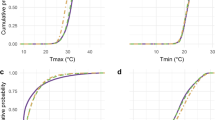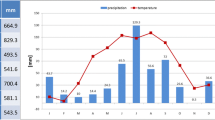Abstract
Aims
Quantification of variations in plant available water holding capacity (PAWC) of soils helps to improve yield forecast and inform spatially variable management practices in dryland agriculture systems. We developed and tested a general inverse approach to estimate PAWC from crop yield.
Methods
The APSIM model was used to simulate wheat yield on synthetic soils with contrasting PAWC and climates. The simulated results were used to develop an empirical model to relate simulated yield to PAWC. The empirical model was inversely used to predict PAWC from observed crop yield. Potential prediction ability was quantified using independently simulated wheat yield on actual soils. The actual ability was assessed with measured wheat yields and PAWC.
Results
The approach had higher accuracy for sites with high rainfall or dominant summer rainfall. It could potentially provide acceptable PAWC predictions across contrasting climate regions (prediction error < 37 mm, 33.5%). The prediction error using crop yield against measured PAWC was <25 mm (26.5%).
Conclusions
Our results demonstrate that soil PAWC can be reliably predicted from crop yield. This approach provides an alternative way to predict PAWC rather than directly measuring it via soil sampling, with profound implications for reducing labour and costs.







Similar content being viewed by others
References
Araya S, Lyle G, Lewis M, Ostendorf B (2016) Phenologic metrics derived from MODIS NDVI as indicators for plant available water-holding capacity. Ecol Indic 60:1263–1272. https://doi.org/10.1016/j.ecolind.2015.09.012
Asseng S, Ewert F, Rosenzweig C, Jones JW, Hatfield JL, Ruane AC, Boote KJ, Thorburn PJ, Rötter RP, Cammarano D, Brisson N, Basso B, Martre P, Aggarwal PK, Angulo C, Bertuzzi P, Biernath C, Challinor AJ, Doltra J, Gayler S, Goldberg R, Grant R, Heng L, Hooker J, Hunt LA, Ingwersen J, Izaurralde RC, Kersebaum KC, Müller C, Naresh Kumar S, Nendel C, O’Leary G, Olesen JE, Osborne TM, Palosuo T, Priesack E, Ripoche D, Semenov MA, Shcherbak I, Steduto P, Stöckle C, Stratonovitch P, Streck T, Supit I, Tao F, Travasso M, Waha K, Wallach D, White JW, Williams JR, Wolf J (2013) Uncertainty in simulating wheat yields under climate change. Nat Clim Chang 3:827–832. https://doi.org/10.1038/nclimate1916
Burk L, Dalgliesh N (2013) GRDC Plant available water capacity
Carlile P, Bui E, Moran C, et al (2001) Estimating soil particle size distributions and percent sand , silt and clay for six texture classes using the australian soil resource information system point database . Canberra
Dalgliesh NP, Foale MA (1998) Soil matters: monitoring soil water and nutrients in Dryland farming. CSIRO Tropical Agriculture, Agricultural Production Systems Research Unit, Toowoomba, QLD
Dalgliesh NP, Hochman Z, Huth N, Holzworth DP (2016) Field protocol to APSoil Characterisations
Florin MJ, McBratney AB, Whelan BM, Minasny B (2011) Inverse meta-modelling to estimate soil available water capacity at high spatial resolution across a farm. Precis Agric 12:421–438. https://doi.org/10.1007/s11119-010-9184-3
Gooley L, Huang J, Pagé D, Triantafilis J (2014) Digital soil mapping of available water content using proximal and remotely sensed data. Soil Use Manag 30:139–151. https://doi.org/10.1111/sum.12094
He D, Wang E (2019) On the relation between soil water holding capacity and dryland crop productivity. Geoderma 353:11–24. https://doi.org/10.1016/J.GEODERMA.2019.06.022
Hochman Z, Dalgliesh NP, Bell KL (2001) Contributions of soil and crop factors to plant available soil water capacity of annual crops on Black and Grey Vertosols. Aust J Agric Res 52:955–961. https://doi.org/10.1071/AR01004
Holzworth DP, Snow V, Janssen S, Athanasiadis IN, Donatelli M, Hoogenboom G, White JW, Thorburn P (2015) Agricultural production systems modelling and software: current status and future prospects. Environ Model Softw 72:276–286. https://doi.org/10.1016/j.envsoft.2014.12.013
Hoogenboom G, Jones JW, Wilkens PW, et al (2015) Decision support system for agrotechnology transfer (DSSAT)
Hunt J, Rees H Van, Hochman Z, et al (2006) Yield prophet ®: an online crop simulation service. In: proceedings of the 13th ASA conference,"ground breaking stuff"
Jiang P, Anderson SH, Kitchen NR, Sudduth KA, Sadler EJ (2007) Estimating plant-available water capacity for claypan landscapes using apparent electrical conductivity. Soil Sci Soc Am J 71:1902–1908. https://doi.org/10.2136/sssaj2007.0011
Jiang P, Kitchen NR, Anderson SH, Sadler EJ, Sudduth KA (2008) Estimating plant-available water using the simple inverse yield model for claypan landscapes. Agron J 100:830. https://doi.org/10.2134/agronj2007.0216
Lawes RA, Oliver YM, Robertson MJ (2009) Integrating the effects of climate and plant available soil water holding capacity on wheat yield. F Crop Res 113:297–305. https://doi.org/10.1016/J.FCR.2009.06.008
Morgan CLS, Norman JM, Lowery B (2003) Estimating plant-available water across a field with an inverse yield model. Soil Sci Soc Am J 67:620–629. https://doi.org/10.2136/sssaj2003.6200
Oliver YM, Robertson MJ (2009) Quantifying the benefits of accounting for yield potential in spatially and seasonally responsive nutrient management in a Mediterranean climate. Aust J Soil Res 47:114. https://doi.org/10.1071/SR08099
Rab MA, Fisher PD, Armstrong RD, Abuzar M, Robinson NJ, Chandra S (2009) Advances in precision agriculture in South-Eastern Australia. IV. Spatial variability in plant-available water capacity of soil and its relationship with yield in site-specific management zones. Crop Pasture Sci 60:885–900. https://doi.org/10.1071/CP08350
Rab MA, Chandra S, Fisher PD, Robinson NJ, Kitching M, Aumann CD, Imhof M (2011) Modelling and prediction of soil water contents at field capacity and permanent wilting point of dryland cropping soils. Soil Res 49:389. https://doi.org/10.1071/SR10160
Timlin D, Pachepsky Y, Walthall C, Loechel S (2001) The use of a water budget model and yield maps to characterize water availability in a landscape. Soil Tillage Res 58:219–231. https://doi.org/10.1016/S0167-1987(00)00170-7
Verburg K, Cocks B, Manning B, et al (2017) APSoil plant available water capacity ( PAWC) characterisation of select Liverpool Plains soils and their landscape context. Canberra
Wallor E, Kersebaum KC, Lorenz K, Gebbers R (2019) Soil state variables in space and time: first steps towards linking proximal soil sensing and process modelling. Precis Agric 20:313–334. https://doi.org/10.1007/s11119-018-9617-y
Wang E, Cresswell H, Xu J, Jiang Q (2009) Capacity of soils to buffer impact of climate variability and value of seasonal forecasts. Agric For Meteorol 149:38–50. https://doi.org/10.1016/j.agrformet.2008.07.001
Wong MTF, Asseng S (2006) Determining the causes of spatial and temporal variability of wheat yields at sub-field scale using a new method of Upscaling a crop model. Plant Soil 283:203–215. https://doi.org/10.1007/s11104-006-0012-5
Zhao Z, Rebetzke GJ, Zheng B, Chapman SC, Wang E (2019) Modelling impact of early vigour on wheat yield in dryland regions. J Exp Bot 70:2535–2548. https://doi.org/10.1093/jxb/erz069
Acknowledgments
This work is funded by the Digiscape Future Science Platform (FSP) of CSIRO. We would like to thank Dr. Brendan Malone and Dr. Xiaoxi Li for their valuable comments on the previous version of the paper.
Author information
Authors and Affiliations
Corresponding authors
Additional information
Responsible Editor: W Richard Whalley
Publisher’s note
Springer Nature remains neutral with regard to jurisdictional claims in published maps and institutional affiliations.
Rights and permissions
About this article
Cite this article
He, D., Oliver, Y. & Wang, E. Predicting plant available water holding capacity of soils from crop yield. Plant Soil 459, 315–328 (2021). https://doi.org/10.1007/s11104-020-04757-0
Received:
Accepted:
Published:
Issue Date:
DOI: https://doi.org/10.1007/s11104-020-04757-0




